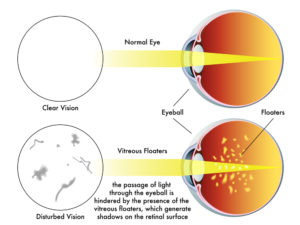Eye “floaters” are deposits or debris within your eye’s vitreous humor. Whether you see specks, wispy threads, strings, or cobweb shapes that drift back and forth when you move your eyes, you are seeing floaters. More precisely, you are seeing the shadows that the floaters cast on your retinas. Floaters can refract light and that temporarily interferes with your vision until the floaters drift into a different position.
Harmless Floaters?
Eye floaters move around, come and go, and eventually settle away from the line of sight after a few weeks. They can be annoying and distracting, but most of the time they are harmless and are not a cause for alarm, however, any sudden onset of new floaters should be examined.
Floaters are suspended in the vitreous humor which fills about 80 percent of the eye. The most common cause of floaters is shrinkage of the vitreous humor. The vitreous humor is 98 to 99% water and the remaining 1 to 2% is a mixture of collagen, proteins, salts, and sugars. Despite the water-to-collagen ratio, the vitreous humor has a firm jelly-like consistency.
Posterior Vitreous Detachment
As we age the vitreous humor shrinks and liquefies and develops a watery center. Portions of the collagen and protein mixture become stringy fibers and these floating stringy collagen and protein fibers are the floaters. This is called a PVD (posterior vitreous detachment).
Sometimes the small floating vitreous fibers pull on retinal cells and that mechanically stimulates the retina cells causing the sensation of flashes of light. This too is not unusual. Floaters and flashes occur at the same time and are mostly harmless annoyances. You have experienced mechanical stimulation of retinal cells if you’ve ever been hit in the eye and afterwards “see stars”.
Treatments
In rare instances floaters can be so closely packed and large or so numerous that they significantly affect vision. In those cases, floaters can be treated with a surgical vitrectomy or a laser vitrectomy. A surgical vitrectomy removes the vitreous humor and replaces it with saline or a bubble made of gas or silicone oil. A laser vitrectomy breaks apart large floaters and vaporizes them.
Floaters and flashes of light that require immediate attention
A sudden onset of numerous floaters, frequent flashes of light, a dark shadow that covers part of your side vision, or eyes that hurt can be symptoms of a tear in your retina and could indicate that your retina is detaching. A detached retina is an emergency and immediate treatment can save your sight.
If you want to make an appointment, please call us (877) 245.2020.
